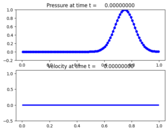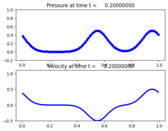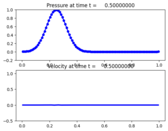1-dimensional acoustics¶
One-dimensional acoustics¶
Solve the (linear) acoustics equations:
\[\begin{split}p_t + K u_x & = 0 \\
u_t + p_x / \rho & = 0.\end{split}\]
Here p is the pressure, u is the velocity, K is the bulk modulus, and \(\rho\) is the density.
The initial condition is a Gaussian and the boundary conditions are periodic. The final solution is identical to the initial data because both waves have crossed the domain exactly once.
Output:¶



Source:¶
#!/usr/bin/env python
# encoding: utf-8
r"""
One-dimensional acoustics
=========================
Solve the (linear) acoustics equations:
.. math::
p_t + K u_x & = 0 \\
u_t + p_x / \rho & = 0.
Here p is the pressure, u is the velocity, K is the bulk modulus,
and :math:`\rho` is the density.
The initial condition is a Gaussian and the boundary conditions are periodic.
The final solution is identical to the initial data because both waves have
crossed the domain exactly once.
"""
from numpy import sqrt, exp, cos
from clawpack import riemann
def setup(use_petsc=False, kernel_language='Fortran', solver_type='classic',
outdir='./_output', ptwise=False, weno_order=5,
time_integrator='SSP104', disable_output=False, output_style=1):
if use_petsc:
import clawpack.petclaw as pyclaw
else:
from clawpack import pyclaw
if kernel_language == 'Fortran':
if ptwise:
riemann_solver = riemann.acoustics_1D_ptwise
else:
riemann_solver = riemann.acoustics_1D
elif kernel_language == 'Python':
riemann_solver = riemann.acoustics_1D_py.acoustics_1D
if solver_type == 'classic':
solver = pyclaw.ClawSolver1D(riemann_solver)
solver.limiters = pyclaw.limiters.tvd.MC
elif solver_type == 'sharpclaw':
solver = pyclaw.SharpClawSolver1D(riemann_solver)
solver.weno_order = weno_order
solver.time_integrator = time_integrator
if time_integrator == 'SSPLMMk3':
solver.lmm_steps = 4
else:
raise Exception('Unrecognized value of solver_type.')
solver.kernel_language = kernel_language
x = pyclaw.Dimension(0.0, 1.0, 100, name='x')
domain = pyclaw.Domain(x)
num_eqn = 2
state = pyclaw.State(domain, num_eqn)
solver.bc_lower[0] = pyclaw.BC.periodic
solver.bc_upper[0] = pyclaw.BC.periodic
rho = 1.0 # Material density
bulk = 1.0 # Material bulk modulus
state.problem_data['rho'] = rho
state.problem_data['bulk'] = bulk
state.problem_data['zz'] = sqrt(rho*bulk) # Impedance
state.problem_data['cc'] = sqrt(bulk/rho) # Sound speed
xc = domain.grid.x.centers
beta = 100
gamma = 0
x0 = 0.75
state.q[0, :] = exp(-beta * (xc-x0)**2) * cos(gamma * (xc - x0))
state.q[1, :] = 0.0
solver.dt_initial = domain.grid.delta[0] / state.problem_data['cc'] * 0.1
claw = pyclaw.Controller()
claw.solution = pyclaw.Solution(state, domain)
claw.solver = solver
claw.outdir = outdir
claw.output_style = output_style
if output_style == 1:
claw.tfinal = 1.0
claw.num_output_times = 10
elif output_style == 3:
claw.nstep = 1
claw.num_output_times = 1
claw.keep_copy = True
if disable_output:
claw.output_format = None
claw.setplot = setplot
return claw
def setplot(plotdata):
"""
Specify what is to be plotted at each frame.
Input: plotdata, an instance of visclaw.data.ClawPlotData.
Output: a modified version of plotdata.
"""
plotdata.clearfigures() # clear any old figures,axes,items data
# Figure for pressure
plotfigure = plotdata.new_plotfigure(name='Pressure', figno=1)
# Set up for axes in this figure:
plotaxes = plotfigure.new_plotaxes()
plotaxes.axescmd = 'subplot(211)'
plotaxes.ylimits = [-0.2, 1.0]
plotaxes.title = 'Pressure'
# Set up for item on these axes:
plotitem = plotaxes.new_plotitem(plot_type='1d_plot')
plotitem.plot_var = 0
plotitem.plotstyle = '-o'
plotitem.color = 'b'
plotitem.kwargs = {'linewidth': 2, 'markersize': 5}
# Set up for axes in this figure:
plotaxes = plotfigure.new_plotaxes()
plotaxes.axescmd = 'subplot(212)'
plotaxes.xlimits = 'auto'
plotaxes.ylimits = [-0.5, 1.1]
plotaxes.title = 'Velocity'
# Set up for item on these axes:
plotitem = plotaxes.new_plotitem(plot_type='1d_plot')
plotitem.plot_var = 1
plotitem.plotstyle = '-'
plotitem.color = 'b'
plotitem.kwargs = {'linewidth': 3, 'markersize': 5}
return plotdata
def run_and_plot(**kwargs):
claw = setup(kwargs)
claw.run()
from clawpack.pyclaw import plot
plot.interactive_plot(setplot=setplot)
if __name__ == "__main__":
from clawpack.pyclaw.util import run_app_from_main
output = run_app_from_main(setup, setplot)
